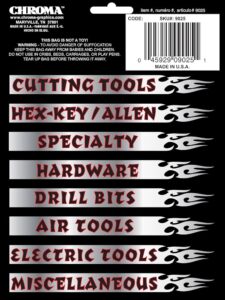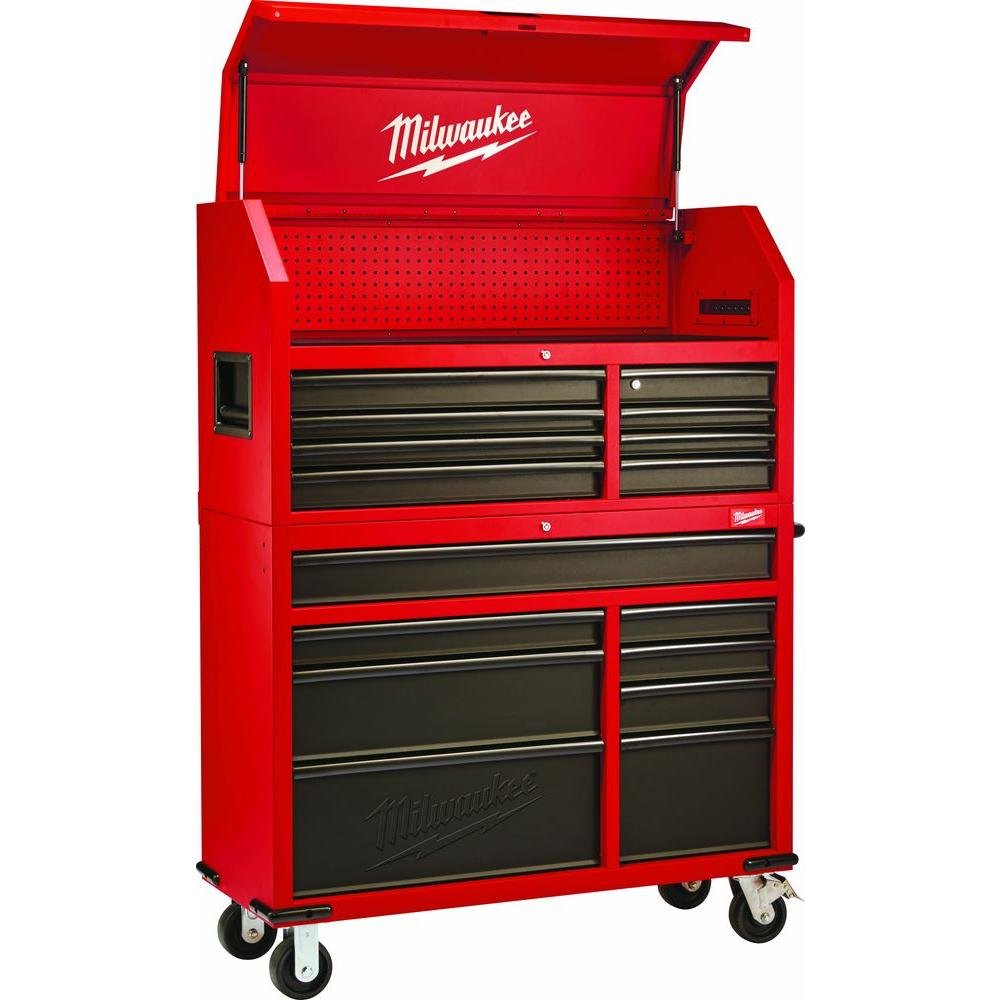
Milwaukee now makes rolling tool chests. This is described as a heavy-duty, 16 drawer tool chest. It is 46 inches wide and 23 inches deep by 62.5 inches tall. It comes in Red and Black and has a power strip and accesories are available for all of you Milwaukee power tools. The Milwaukee Rolling Tool Chest Retails for just under $2400.
A mechanics’ tool box rolling chest is a wheeled storage system designed to organize and transport tools efficiently in automotive and garage work environments. These mobile storage units typically feature multiple drawers, locking mechanisms, and sturdy construction to withstand heavy use in professional settings.
Rolling tool chests combine the storage capacity of traditional toolboxes with the mobility needed for modern automotive repair work. Most models range from 5 to 16 drawers and include features like lockable wheels, detachable top boxes, and adjustable shelving systems. The steel construction ensures durability while the rolling design allows mechanics to bring their tools directly to their work area.
Choosing the right rolling tool chest depends on several factors, including storage needs, workspace size, and budget considerations. Professional mechanics often prefer larger capacity models with specialized organization features, while home garage users may benefit from more compact designs. Understanding the different types, essential features, and maintenance requirements helps users make informed decisions about their tool storage investments.
Key Takeaways
- Rolling tool chests provide mobile storage solutions that combine large capacity with easy transportation for automotive work
- Essential features include drawer configurations, locking mechanisms, wheel quality, and steel construction for durability
- Proper sizing, organization systems, and regular maintenance extend the lifespan and functionality of rolling tool storage
What Is a Mechanics Tool Box Rolling Chest?
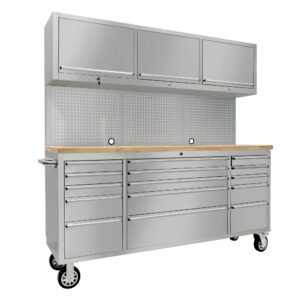
A mechanics’ tool box rolling chest is a large, mobile storage unit designed specifically for professional mechanics and serious DIY enthusiasts. These units combine extensive tool organization with portability through heavy-duty wheels and handles.
Definition and Primary Functions
A mechanics’ tool box rolling chest is a multi-drawer storage system mounted on wheels that allows users to transport their entire tool collection easily. The primary function is to organize and protect valuable tools while providing mobility around a workspace.
These chests typically feature multiple drawers of varying sizes to accommodate different tool types. Small drawers hold precision instruments like wrenches and screwdrivers. Larger drawers store power tools and bulky equipment.
The rolling design serves mechanics who work on different vehicles throughout the day. Instead of walking back and forth to a stationary toolbox, they can roll their entire collection to each job site.
Most rolling chests include ball-bearing drawer slides for smooth operation under heavy loads. The wheels are designed to handle the weight of fully loaded drawers without breaking or jamming.
Key Features That Distinguish Rolling Chests
Rolling chests stand apart from other tool storage through several key features. Heavy-duty casters with brake systems provide stability during use and mobility when needed.
The drawer configuration typically includes shallow top drawers for small hand tools and deeper bottom drawers for larger equipment. Many models feature tubular handles that extend for easy pulling and pushing.
Steel construction is standard, with powder-coated finishes that resist scratches and rust. Some models include foam drawer liners or dividers to prevent tools from sliding around during transport.
Advanced rolling chests may include built-in power outlets and USB ports for charging cordless tools. Work surfaces on top provide additional functionality for small repairs or paperwork.
The size range varies from compact 3-drawer units to massive 16-drawer systems that can hold thousands of dollars worth of tools.
How Rolling Chests Differ From Other Tool Storage Solutions
Rolling chests differ significantly from portable tool boxes and stationary tool cabinets in both capacity and mobility. Unlike small tool boxes, rolling chests can store complete tool collections for professional mechanics.
Stationary tool cabinets offer similar storage capacity but cannot move around a workspace. This makes them less practical for mechanics who work on multiple vehicles or in different areas of a shop.
Tool carts provide mobility but typically have open storage that exposes tools to dust and damage. Rolling chests protect tools in enclosed drawers while maintaining portability.
The weight capacity of rolling chests far exceeds portable options. Professional models can hold 200-500 pounds of tools across multiple drawers without compromising mobility.
Security features like locking mechanisms are more robust in rolling chests compared to basic toolboxes. This protects expensive tool investments in professional environments.
Types of Mechanics Tool Box Rolling Chests
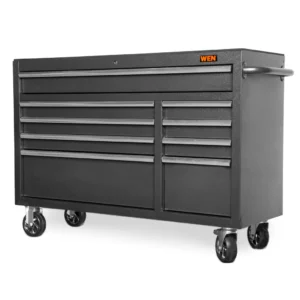
WEN 52-Inch Premium Rolling Tool Cabinet with Heavy Duty 21-Gauge Powder-Coated Steel Construction is a great option for under $675
Rolling tool chests come in several main configurations that serve different workshop needs and budgets. Each type offers unique storage capacities, mobility features, and build quality levels designed for specific user requirements.
Top Chest and Cabinet Combos
Top chest and cabinet combos provide the most storage space for professional mechanics. These units feature a large base cabinet with multiple drawers, plus a separate top chest that sits on top.
The base cabinet typically contains 6-12 deep drawers. These drawers can hold larger tools like wrenches, socket sets, and power tools. The top chest adds 4-8 smaller drawers for frequently used items.
Key features include:
- Total storage capacity of 10-20 drawers
- Separate locking mechanisms for each section
- Heavy-duty casters rated for 500+ pounds
- Side compartments for long tools
Most combo units measure 40-56 inches wide and 72 inches tall. The top chest can be removed for transport to job sites. Professional models often include ball-bearing drawer slides and reinforced construction.
Professional-Grade vs. DIY Models
Professional-grade rolling chests cost $800-$3000 and feature heavy-duty steel construction. They use thick-gauge steel and precision welding techniques. Ball-bearing drawer slides handle frequent daily use without wearing out.
These models include advanced locking systems with master keys. Anti-rust coatings protect against shop chemicals and moisture. Drawer weight capacities range from 75-150 pounds each.
DIY models cost $200-$800 and work well for weekend mechanics. They use thinner steel and basic drawer slides. Weight capacities are lower at 35-75 pounds per drawer.
Professional features:
- Steel thickness: 18-20 gauge vs. 22-24 gauge
- Drawer slides: Ball-bearing vs. basic rollers
- Warranty: 5-10 years vs. 1-2 years
DIY models still offer good organization for home garages. They include basic locking and adequate storage space.
Portable and Compact Rolling Chests
Portable rolling chests measure 26-36 inches wide and work well in smaller spaces. They typically feature 4-8 drawers and weigh 100-200 pounds when loaded.
These units fit through standard doorways and can be moved between work areas easily. Many include removable top trays for carrying tools to specific jobs.
Compact models sacrifice some storage for better mobility. They work well for mobile mechanics or multi-bay shops. Most include sturdy casters and ergonomic handles for easy movement.
Common sizes:
- Small: 26″ wide, 6 drawers, 150 lb capacity
- Medium: 32″ wide, 8 drawers, 250 lb capacity
- Large: 36″ wide, 10 drawers, 350 lb capacity
Some portable units include fold-down side shelves. Others feature magnetic strips or hooks for additional tool storage.
Essential Features to Consider
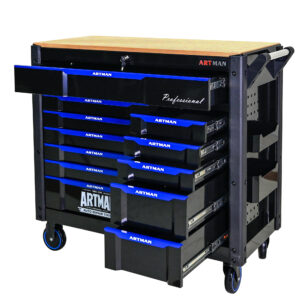
Heavy Duty Rolling Tool Chest with 12-Drawer Tool Cart by Artman is a great buy for the young mechanic who doesn’t have tons of tools.
A rolling tool chest’s effectiveness depends on specific design elements that impact daily use. The drawer system, security features, construction materials, and mobility components determine how well the chest serves professional mechanics and DIY enthusiasts.
Drawer Configuration and Layout
The number and size of drawers directly affect tool organization and accessibility. Most rolling tool chests feature 4 to 13 drawers in different configurations.
Standard drawer layouts include:
- Shallow top drawers for small hand tools
- Medium drawers for wrenches and pliers
- Deep bottom drawers for power tools
Drawer depth typically ranges from 2 to 8 inches. Shallow drawers work best for screwdrivers, bits, and measuring tools. Deep drawers accommodate larger items like impact guns and air tools.
Full-extension drawer slides allow complete access to contents. Ball-bearing slides handle heavier loads better than basic roller slides. Look for slides rated for at least 100 pounds per drawer.
Interior dividers and foam inserts help organize tools within drawers. Some chests include removable dividers that users can adjust based on their tool collection.
Locking Mechanisms and Security
Tool security protects expensive equipment from theft and unauthorized access. Most rolling tool chests use central locking systems that secure all drawers with one key.
Common locking types include:
- Tubular locks with round keys
- Traditional key locks
- Electronic locks with keypads
Central locking mechanisms connect all drawers through internal cables or rods. This system prevents individual drawers from opening when locked.
Lock quality varies significantly between manufacturers. Higher-end chests use pick-resistant locks with hardened steel components. Budget models may use basic locks that offer minimal security.
Some chests include separate locks for top and bottom sections. This feature allows users to secure valuable tools while keeping frequently used items accessible.
Material and Build Quality
Steel gauge determines the chest’s strength and durability. Most quality rolling tool chests use 18 to 20-gauge steel construction.
Steel thickness breakdown:
- 18-gauge: 0.048 inches thick (heavy-duty)
- 20-gauge: 0.036 inches thick (standard)
- 22-gauge: 0.030 inches thick (light-duty)
Thicker steel costs more but provides better dent resistance and longer life. Professional-grade chests typically use 18-gauge steel for the frame and 20-gauge for drawer fronts.
Powder coating protects steel from rust and scratches. Quality manufacturers apply multiple coating layers for enhanced protection. Some chests feature textured finishes that hide fingerprints and minor damage.
Welded construction creates stronger joints than bolted assemblies. Look for continuous welds rather than spot welds at stress points.
Wheels and Mobility Options
Wheel quality affects how easily the chest moves across different surfaces. Most rolling tool chests use 5 to 6-inch wheels for smooth operation.
Wheel types and benefits:
- Polyurethane wheels: Quiet operation, floor protection
- Rubber wheels: Good traction, shock absorption
- Steel wheels: Maximum durability, heavy-load capacity
Four-wheel designs provide stability but require more effort to maneuver. Some chests include two fixed wheels and two swivel casters for easier turning.
Wheel locks prevent the chest from rolling during use. Look for foot-operated locks that engage easily without bending over.
Heavy-duty ball bearing wheels handle loaded chests better than basic bushings. Quality wheels support 200 to 400 pounds without binding or wobbling.
Handle height affects pushing comfort. Telescoping handles adjust to different user heights, while fixed handles work best at 36 to 42 inches high.
Choosing the Right Size and Capacity
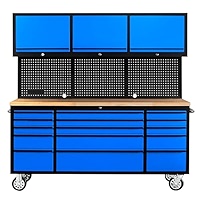
The right size mechanics toolbox balances storage needs with workshop space limits. Tool count, drawer capacity, and weight restrictions determine which rolling chest works best for specific situations.
Assessing Your Tool Storage Needs
A mechanic’s tool collection determines the chest size needed. Count hand tools, power tools, and specialty equipment first.
Small collections under 100 pieces fit in 4-6 drawer chests. These work well for basic automotive repairs and home mechanics.
Medium collections need 7-10 drawers. These handle most professional mechanics’ daily tools, including wrenches, sockets, and diagnostic equipment.
Large collections require 11+ drawers or combination units. Shops with multiple mechanics or specialized tools need these bigger systems.
Tool categories to count:
- Hand tools (wrenches, screwdrivers, pliers)
- Socket sets and ratchets
- Power tools and chargers
- Diagnostic equipment
- Specialty automotive tools
Drawer depth matters too. Standard drawers hold 3-4 inches of tools. Deep drawers store power tools and bulky items up to 6 inches tall.
Space Considerations for Workshops
The workshop layout affects tool chest size choices. Measure available floor space before buying.
Standard rolling chests range from 26 to 72 inches wide. Depth runs 18 to 24 inches typically.
Common size ranges:
- Compact: 26-30 inches wide
- Mid-size: 40-50 inches wide
- Full-size: 60-72 inches wide
Doorway width limits moving options. Most shop doors are 36 inches wide. Wider chests may not fit through standard openings.
Ceiling height affects top chest additions. Stack combinations can reach 70 inches tall. Low ceilings limit vertical storage options.
Rolling space needs extra room. Add 36 inches to sides where the chest moves. This prevents hitting walls or other equipment.
Load Ratings and Weight Limits
Weight capacity varies by construction and price. Steel chests handle more weight than aluminum or plastic versions.
Drawer weight limits:
- Light duty: 35-50 pounds per drawer
- Heavy duty: 100-150 pounds per drawer
- Industrial: 200+ pounds per drawer
Total chest capacity includes the unit’s weight. A 300-pound chest with a 1000-pound capacity holds 700 pounds of tools maximum.
Ball bearing slides support more weight than plastic guides. Full-extension drawers with metal slides last longer under heavy loads.
Floor conditions affect rolling performance. Smooth concrete handles heavy chests well. Uneven surfaces or gravel make moving difficult with full loads.
Consider future tool purchases when selecting capacity. Buy 25% more capacity than current needs to allow growth.
Organization and Customization Options
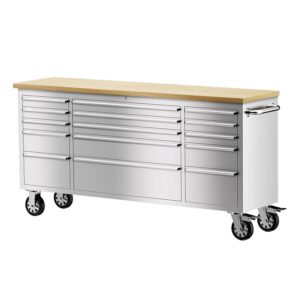
The Chetto 72 inch is another great option for $1100.
A well-organized rolling tool chest saves time and prevents lost tools. The best systems use drawer organizers, modular designs, and clear labeling to keep everything in its place.
Drawer Organizers and Inserts
Drawer organizers transform empty spaces into efficient storage zones. Foam inserts cut to exact tool shapes prevent movement during transport. They also show missing tools at a glance.
Plastic dividers create adjustable compartments for different tool sizes. These work well for screws, bolts, and small parts. Removable trays lift out for close work access.
Metal organizers offer the strongest option. They resist damage from heavy tools and sharp edges. Many feature magnetic strips to hold wrenches and sockets.
Socket rails keep drive tools organized by size. Ball-bearing rails slide smoothly and lock sockets in place. Spring-loaded rails work with metric and standard sizes.
Modular and Expandable Systems
Modular tool chests grow with changing needs. Swappable drawers allow custom configurations between different tool sets. Users can move entire drawers between workstations.
Stackable units connect multiple chests together. They share the same wheel base while adding storage height. This works well in shops with limited floor space.
Detachable organizers remove completely from the main chest. These portable units move to job sites while larger tools stay behind. They often include handles for easy carrying.
Side cabinets attach to main units for extra storage. They typically hold larger items like power tools and supplies. Most feature independent locks for security.
Labeling and Inventory Solutions
Clear labels prevent tools from ending up in wrong drawers. Waterproof labels resist oil and cleaning products common in garages. They stick to metal surfaces without peeling.
Color-coded systems assign different colors to tool types. Red might indicate electrical tools while blue marks automotive tools. This speeds up visual searches.
Inventory sheets track tool locations and quantities. They attach inside drawer fronts or chest lids. Some mechanics use smartphone apps to scan and track tools.
Photo labels show exact tool placement. They help others return borrowed tools to correct spots. This works especially well in shared workspace environments.
Top Brands and Manufacturers
Several major brands dominate the mechanic’s rolling tool chest market. Each brand offers different features and price points to meet various needs.
Snap-on stands out as a premium choice for professional mechanics. The company has 100 years of experience in the automotive industry. Their tool chests cost more but many professionals prefer this brand for its quality.
Craftsman produces popular models like the 6 Drawer Tool Chest. This brand offers good capacity for the price. Many mechanics choose Craftsman for reliable performance without breaking the budget.
Montezuma creates unique designs like the SM200B TRIANGLE Toolbox. Their products focus on innovative shapes and layouts. The brand appeals to users who want something different from standard rectangular chests.
Goplus makes affordable rolling tool chests that work well outdoors. Their 6-Drawer Rolling Tool Chest handles tough conditions. This brand suits mechanics who need portable storage for job sites.
WEN offers budget-friendly options without sacrificing basic quality. The WEN 73015 model appears in many top tool chest lists. This brand works well for home mechanics and occasional users.
Thor Kitchen produces attractive stainless steel tool chests with workstations. Their anti-fingerprint finish looks professional. The rubberwood work surface adds functionality to the design.
These brands cover different price ranges and feature sets. Professional mechanics often prefer Snap-on or Craftsman. Home users typically choose Goplus, WEN, or Thor Kitchen based on their specific needs.
Maintenance and Longevity Tips
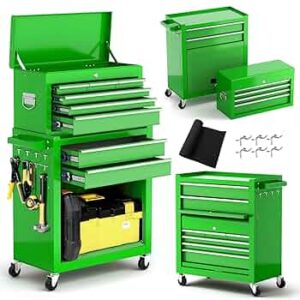
Intergreat is a much less expensive option for mechanics. This unit can be purchased for under $150.
A rolling tool chest requires regular upkeep to maintain smooth operation and prevent costly repairs. Simple cleaning, lubrication, and rust prevention steps can extend the life of your investment by years.
Routine Cleaning Practices
Clean your rolling tool chest weekly to prevent dirt buildup and maintain smooth operation. Remove all tools from each drawer before cleaning.
Weekly Cleaning Steps:
- Wipe down all surfaces with a damp cloth
- Vacuum or brush out drawer debris
- Clean the exterior with mild soap and water
- Dry all surfaces completely
Pay special attention to the bottom of the chest where road grime accumulates. Use a stiff brush to remove stubborn dirt from the wheels and casters.
Monthly Deep Cleaning:
- Remove drawers completely for thorough cleaning
- Wash drawer liners or replace if damaged
- Clean drawer slides and tracks
- Inspect for damage or wear
Avoid harsh chemicals that can damage painted surfaces. Use compressed air to blow out tight spaces where dirt collects.
Lubricating Slides and Moving Parts
Proper lubrication keeps drawers sliding smoothly and prevents premature wear. Apply lubricant every three months or when drawers become difficult to open.
Key Lubrication Points:
- Drawer slides and tracks
- Lock mechanisms
- Wheel bearings and axles
- Hinges on lids or doors
Use white lithium grease for drawer slides and wheel bearings. Apply a small amount to each slide track and work the drawer back and forth several times.
Lubrication Schedule:
- Light use: Every 6 months
- Heavy use: Every 3 months
- After exposure to moisture: Immediately
Wipe away excess lubricant to prevent dirt accumulation. Never use WD-40 on precision slides as it attracts dirt over time.
Preventing Rust and Corrosion
Moisture is the biggest enemy of metal tool chests. Store your chest in a dry location whenever possible.
Rust Prevention Methods:
- Apply paste wax to painted surfaces twice yearly
- Use moisture-absorbing packets in drawers
- Keep chest covered when not in use
- Address scratches immediately with touch-up paint
Inspect your chest monthly for signs of rust or corrosion. Small rust spots can be removed with fine steel wool and treated with rust converter.
High-Risk Areas:
- Wheel mounting points
- Drawer slide contact points
- Areas where paint is chipped
- Bottom edges that contact the ground
Apply a thin coat of automotive wax to protect the finish. This creates a barrier against moisture and makes cleaning easier.
Common Uses in Automotive and Garage Work
Rolling tool chests serve as essential storage solutions for mechanics working on vehicles, from professional auto shops to home garages. These mobile units keep tools organized and accessible while moving around different work areas.
Professional Mechanic Applications
Professional mechanics rely on rolling tool chests to store comprehensive collections of automotive tools. These include wrenches, ratchets, screwdrivers, and specialized equipment needed for various vehicle repairs.
The multi-drawer design allows mechanics to organize tools by type or function. Socket sets go in one drawer while diagnostic tools occupy another. This system saves time during repairs.
Rolling capability becomes crucial in busy auto shops. Mechanics can move their entire tool collection from one service bay to another without multiple trips. The wheels handle the weight of hundreds of tools easily.
Key tool categories stored include:
- Hand tools (wrenches, screwdrivers, pliers)
- Power tools and attachments
- Diagnostic equipment
- Specialty automotive tools
- Small parts and fasteners
Standing tool boxes often line garage walls in professional settings. Each unit holds precision tools needed for specific vehicle systems. This setup maximizes workspace efficiency.
Home Garage and Hobbyist Use
Home mechanics use rolling tool chests for weekend car projects and routine maintenance. These units provide professional-level organization in smaller spaces.
The mobility factor helps hobbyists work on different vehicles or projects. They can roll tools from the garage to the driveway easily. This flexibility suits varied home workshop needs.
Storage capacity matters for growing tool collections. DIY mechanics start with basic hand tools and gradually add specialized equipment. Rolling chests accommodate this expansion better than fixed toolboxes.
Popular home garage applications:
- Oil changes and fluid maintenance
- Brake repairs and replacements
- Engine tune-ups
- Bodywork and detailing
- Seasonal maintenance tasks
The drawer configuration keeps tools visible and accessible. Home mechanics spend less time searching for the right tool during projects.
Mobile Repair Services
Mobile mechanics depend on rolling tool chests for on-site vehicle repairs. These units must be compact enough for transport while holding essential tools.
The portability allows mechanics to bring professional-grade equipment to customer locations. They can service vehicles at homes, offices, or roadside emergencies.
Weight distribution becomes important for mobile applications. Rolling chests spread tool weight across multiple drawers and wheels. This makes loading and unloading from service vehicles easier.
Mobile service requirements:
- Compact size for van transport
- Secure drawer locks for travel
- Durable wheels for various surfaces
- Weather-resistant construction
- Quick setup and breakdown
Some mobile mechanics use multiple smaller rolling units instead of one large chest. This approach provides better flexibility for different service calls.
Safety Guidelines for Using Rolling Tool Chests
Rolling tool chests require careful handling to prevent injury and tool damage. Proper loading techniques, mobility practices, and transport security measures protect both the user and expensive equipment.
Safe Loading and Unloading
Weight distribution is critical when loading a rolling tool chest. Place heavy tools like socket sets and wrenches in the bottom drawers. This keeps the center of gravity low and prevents tipping.
Light tools should go in upper drawers. Items like screwdrivers, pliers, and small hand tools work well in top compartments.
Drawer weight limits must be followed. Most standard drawers handle 50-75 pounds safely. Heavy-duty drawers can hold up to 100 pounds.
Users should load drawers gradually. Adding too much weight at once can damage the drawer slides or cause the chest to become unstable.
Proper lifting technique prevents back injury. Bend at the knees when placing heavy items in lower drawers. Keep the back straight and lift with leg muscles.
Never overload a single drawer while leaving others empty. This creates an unbalanced chest that tips easily when drawers are opened.
Proper Mobility Techniques
Pre-movement inspection should happen before rolling any tool chest. Check that all drawers are completely closed and latched. Open drawers can catch on objects or cause the chest to tip.
Test the wheels and casters for damage. Cracked or worn wheels can fail during transport and cause accidents.
Rolling technique matters for safety. Push the chest rather than pulling it. This provides better control and prevents the chest from rolling into the user’s legs.
Move at a walking pace. Rolling too fast reduces reaction time if obstacles appear.
Clear pathways before moving the chest. Remove tools, cords, and debris from the planned route. Check for oil spills or wet spots that could cause slipping.
Turn corners slowly and carefully. Quick turns can cause the chest to tip or hit walls and equipment.
Securing Chests During Transport
Locking mechanisms must be engaged before any movement. Modern rolling chests have drawer locks that prevent accidental opening during transport.
The main lock should secure all drawers simultaneously. This is faster than locking each drawer individually.
Wheel locks or brakes should be set when the chest is stationary. This prevents unwanted rolling on sloped surfaces or when drawers are opened.
Some chests have automatic wheel locks that engage when the handle is released. These provide hands-free security.
Tie-down requirements apply when transporting chests in vehicles. Use ratchet straps or chains to secure the chest to the truck bed or trailer.
Attach straps to solid mounting points on the chest frame. Avoid securing straps to drawer handles or lightweight components that could break.
Cover the chest with a tarp during outdoor transport. This protects against weather and prevents tools from falling out if a drawer comes loose.
Upgrading and Accessorizing Your Rolling Chest
Many tool box accesories for tool boxes are available on Amazon as well.
A basic rolling tool chest can become much more useful with strategic upgrades. Key improvements include adding electrical components for better visibility and convenience, installing high-security locks for protection, and applying custom finishes for durability and appearance.
Adding Lighting and Power Outlets
LED strip lights transform a dark tool chest into a bright workspace. Users can install battery-powered LED strips along the inside edges of drawers for hands-free illumination.
Hardwired LED systems work better for permanent setups. These connect to a 12V power supply and provide consistent lighting without battery changes.
Power outlet installation requires basic electrical skills. A mechanic can mount a power strip to the side panel or install individual outlets in the top section.
Key electrical components include:
- LED strip lights (battery or hardwired)
- 12V power supply for permanent lighting
- USB charging ports for phones and tablets
- Standard outlets for power tools
The wiring runs through existing holes or new openings drilled in the back panel. Users should connect all electrical components to a single power cord that plugs into a wall outlet.
Retrofitting With Advanced Locks
Basic key locks on tool chests offer minimal security. Electronic locks provide better protection and convenience for valuable tools.
Digital keypad locks replace standard key cylinders. These accept 4-6 digit codes and eliminate the need for physical keys. Most models include backup key access if the battery dies.
Biometric locks use fingerprints for access. They store multiple fingerprints and work well in busy shops where several people need access.
Heavy-duty hasp locks add extra security to valuable collections. These bolt-on units work with high-security padlocks and resist cutting attempts.
Lock upgrade options:
- Digital keypad (4-6 digit codes)
- Biometric scanner (fingerprint access)
- Heavy-duty hasp with padlock
- Central locking system (locks all drawers at once)
Installation typically requires drilling new holes and removing the old lock cylinder. Most electronic locks run on AA batteries that last 6-12 months.
Custom Paint and Finishes
Factory paint on tool chests often chips and scratches with regular use. Custom paint jobs provide better protection and personal style.
Automotive paint works best for durability. Two-part epoxy paints resist chemicals, impacts, and scratches better than regular spray paint.
The prep work determines paint quality. Users must sand the entire surface, clean with degreaser, and apply primer before the base coat.
Powder coating offers the strongest finish. Professional powder coating costs more but creates a thick, chip-resistant surface that lasts for years.
Popular finish options include:
- Gloss black (classic professional look)
- Metallic silver (hides scratches well)
- Custom colors (personal or company branding)
- Textured finishes (better grip, hides imperfections)
Clear coat application protects the color and adds shine. Users should apply 2-3 thin coats rather than one thick layer to prevent runs and drips.
Environmental Impact and Sustainable Choices
Rolling tool chests can impact the environment through their materials and manufacturing. Steel and aluminum boxes last longer than plastic ones. This means fewer replacements over time.
Eco-friendly materials help reduce environmental harm. Some manufacturers now use recycled metals in their tool chests. Others focus on reducing packaging waste.
Durability plays a key role in sustainability. A well-built rolling chest can last 10-20 years. Cheap boxes may break within 2-3 years.
| Material | Lifespan | Recyclability |
|---|---|---|
| Steel | 15-20 years | High |
| Aluminum | 12-18 years | Very High |
| Plastic | 3-5 years | Low |
Heavy-duty construction reduces waste by lasting longer. Users don’t need to replace broken drawers or bent frames as often.
Proper recycling matters when tool chests reach end of life. Steel and aluminum can be melted down and reused. Many scrap yards accept old tool boxes.
Some features reduce environmental impact:
- Powder coating instead of paint
- Recyclable packaging materials
- Local manufacturing to cut shipping
Users can extend their tool chest’s life by maintaining it properly. Regular cleaning and oiling of drawer slides prevents rust. This keeps the chest working for many years.
Buying quality over quantity helps the environment. One durable rolling chest beats three cheap replacements.
Frequently Asked Questions
Professional mechanics often need specific features like heavy-duty drawer slides and quality steel construction. Finding the right tool chest involves considering factors like steel gauge thickness, brand reliability, and safe transport methods.
What are the features to look for in the best mechanics rolling tool chest?
Heavy-duty steel construction stands as the most important feature. The chest should have thick steel walls and reinforced corners.
Quality drawer slides make daily use smooth and reliable. Ball-bearing slides handle heavy loads better than basic slides.
Multiple drawer sizes help organize different tools. Small drawers work well for hand tools while larger ones hold power tools.
Internal locking systems keep tools secure. This prevents unauthorized access and protects valuable equipment.
A flat work surface on top provides extra space. Mechanics can place frequently used tools and parts there during jobs.
How can I find deals or clearances on rolling tool chests with drawers?
End-of-season sales often offer the best discounts. Tool retailers clear inventory before new models arrive.
Online retailers frequently run flash sales. Checking websites weekly helps catch limited-time offers.
Trade shows and professional events sometimes feature special pricing. Manufacturers offer discounts to attract new customers.
Refurbished or open-box items cost less than new ones. These often work perfectly but may have minor cosmetic issues.
What methods are recommended for safely transporting a rolling tool chest?
Empty all drawers before moving the chest. This prevents damage to tools and makes the chest lighter.
Lock all drawers to prevent them from sliding open. Use the internal locking system or tape them shut.
Level surfaces work best for rolling. Avoid stairs, curbs, and uneven ground when possible.
Two people should handle heavy chests. One person pulls while the other guides and stabilizes.
Use moving straps when loading into vehicles. Secure the chest to prevent shifting during transport.
How does the steel gauge affect the durability of a mechanic’s rolling tool chest?
Lower gauge numbers mean thicker steel. 20-gauge steel is thicker and stronger than 22-gauge steel.
Thicker steel resists dents and damage better. Heavy tools and daily use require stronger construction.
The frame and drawer construction both matter. Thin steel can warp under heavy loads over time.
Professional-grade chests typically use 16 to 20-gauge steel. This provides the strength needed for daily commercial use.
Which brands offer the most reliable rolling tool chests for professional mechanics?
Snap-on produces high-end professional tool chests. Their products cost more but offer superior quality and durability.
Craftsman provides good value for professional use. Their chests balance quality with reasonable pricing.
Husky makes reliable chests available at Home Depot. They offer solid construction at competitive prices.
Milwaukee focuses on portable and modular systems. Their Packout line works well for mobile mechanics.
Mac Tools specializes in professional-grade equipment. They offer financing options for working mechanics.
Are there sturdy alternatives to rolling tool chests for storing mechanic tools?
Stationary tool cabinets offer more storage space. They work well in fixed garage locations but cannot move.
Portable tool bags suit mobile mechanics. They carry essential tools but hold less than chests.
Tool carts provide mobility with smaller capacity. They work well for specific jobs or apprentice mechanics.
Wall-mounted pegboards save floor space. They keep frequently used tools visible and accessible.
Modular storage systems allow custom configurations. Mechanics can build systems that fit their specific needs.
